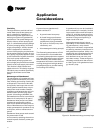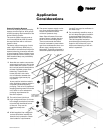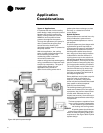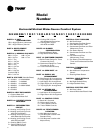
28 WSHP-PRC001-EN
Sound control applies to the return
side of the duct design as well as the
supply side. Figure 36, demonstrates
a poor installation. Note that the
return air opening is close to the
cabinet of the unit.
Figure 37 graphic represents proper
installation of return-air duct. This
includes
• Two 90-degree bends prior to the
intake
• Lining the first 10 feet of the
return air duct
• Locating the return-air intake
away from the unit blower
A duct system with noise control
in-mind can be designed by:
• Keeping air flow velocities low
• Using aerodynamic fittings
• Using a duct liner if metal duct is
applied
• Avoiding line-of-sight connec-
tions between a noise source and
an outlet
• Avoiding line-of-sight connection
between a noise source and an
inlet
• By properly locating balancing
dampers
• Sealing cracks, seams and joints
in the duct run and equipment
panels
• Blocking transmission through
walls, ceiling and floors
• Mounting and supporting the
ductwork with isolation devices
that absorb vibration
• Using flexible duct connections
• Using flexible braided hoses on
the water connections
Application
Considerations
Figure 36: Improper return-air ducting
Figure 37: Proper return-air ducting


















